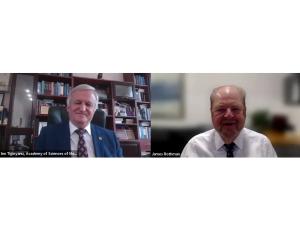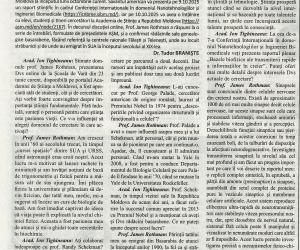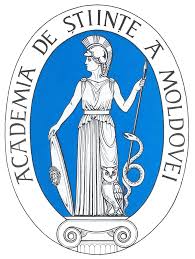- Views: 163
Prof. James Rothman: Science prospers when it develops internationally and draws from all the world’s talents,
and countries that encourage these talents prosper accordingly.
On September 4th, 2025, Prof. Ion Tighineanu, President of the Academy of Sciences of Moldova, had an online discussion with Prof. James Rothman from Yale University, USA, Nobel Prize Laureate in Medicine, who will visit the Republic of Moldova in early October. The American scientist will present a scientific report on October 9th, 2025 at the International Conference on Nanotechnologies and Biomedical Engineering (https://icnbme.sibm.md/), and on October 10th, 2025 he will have a meeting with students and young researchers in the Blue Hall of the Academy of Sciences of Moldova (https://asm.md/en/node/2167). During the online discussion, Prof. James Rothman answered a series of questions posed by the president of the ASM, and confirmed his Bessarabian genealogical roots, referring to the district centers of Fălești and Telenești, where his great-grandparents lived and from where they emigrated to the USA at the beginning of the 20th century.
Dr. Tudor Braniste
Ion Tighineanu: Dear Prof. James Rothman, your online presentation at the Summer School on 23rd of June, being available on the portal of the Academy of Sciences of Moldova, was enjoyed by both students and researchers. You spoke very convincingly about the importance of fundamental science. It is no doubt that you are a person for whom science is the passion of life. What influenced you to choose the research field in which you work?
James Rothman: I grew up in the 1960s during the “space race” between the US and USSR, when astronauts were our heroes. This motivated me to launch model rockets and I learned basic trigonometry and physics to measure how high they reached. I loved physics in university and planned to be a physicist, but my father, a medical doctor, suggested I try one course in basic biology. I was hooked right away by the idea that life could be explained at the level of physical chemistry. That has been my passion ever since, and has driven all my research in biochemistry.
Ion Tighineanu: Have you closely collaborated with Prof. Randy Schekman? How you and Prof. Randy Schekman reached the achievements which brought you the Nobel Prize in Physiology or Medicine in 2013?
James Rothman: Schekman’s research and mine were highly complementary. He studied secretion in yeast, initially by genetics. I studied intracellular protein transport in mammalian cells using biochemical methods. Ultimately, we identified the same machinery that forms and fuses transport vesicles, but using very different methods reinforced the truth of our conclusions as well as their generality.
James Rothman: Along the way, we consistently studied and discussed each others’ results as our projects bore fruit, and consistently influenced each others’ research paths over 2 decades. But we rarely actively shared the same project, and have published only 1 or 2 papers together.
Ion Tighineanu: Have you known Prof. George Palade, US researcher of Romanian origin, winner of the Nobel Prize in 1974 for the “discoveries concerning the structural and functional organization of the cell”?
James Rothman: Palade had a great influence on Schekman and me, both in person and through his pioneering work which we built upon. So, yes, we knew and admired him personally. When I moved to Yale in 2008 it was to lead the Department of Cell Biology which Palade had founded in the 1970s when he moved to Yale from the Rockefeller University.
Ion Tighineanu: Prof. Schekman during his visit to the Republic of Moldova two years ago referred to the joint success appreciated with the Nobel Prize, and mentioned that you also have Bessarabian roots. What can you tell us about this?
James Rothman: My fathers’ parents emigrated from then-Bessarabia in the early 1900s, as did Schekman’s ancestors somewhat earlier. Isn’t it remarkable that two Nobel Laureates would have roots in the same small region? And even more of a wonder that they would choose the same research question and ultimately share the same Prize?
Ion Tighineanu: The portal of the Academy of Sciences of Moldova informed us about your visit to the homeland of your predecessors, which will take place in the first half of October. Will you visit the towns where your predecessors lived?
James Rothman: Yes, I am looking forward to visiting both Fălești and Telenești and to learn how people lived in the 19th century and how they do so today.
Ion Tighineanu: Professor Rothman, what are your expectations from your visit to the Republic of Moldova?
James Rothman: I am looking forward to getting to know more Moldovan scientists, and meeting students who may be interested in careers in science and technology. Science prospers when it develops internationally and draws from all the world’s talents, and countries that encourage these talents prosper accordingly.
Ion Tighineanu: At the 7th International Conference on Nanotechnologies and Biomedical Engineering you will present the plenary report “The biophysical basis of rapid information transmission in the brain”. Can you tell more details about your current research interests?
James Rothman: Synapses are the connections between the nerve cells in our brain. There are about 1000 times as many synapses as there are nerve cells, and it is these synapses that process information, store memories, and set the speed of thought and perception. Imbalances in synaptic function or wholesale loss of these connections over time cause diseases ranging from mood disorders to neurodegenerative conditions. We are investigating synaptic transmission at its deepest level and have made a landmark advance which I will describe in my report: an entirely synthetic test-tube replica of the upstream (pre-synaptic) side of the synapse, assembled from the full set of pure proteins into artificial synaptic vesicle and cell membranes. This system reproduces the ultra-fast release of neurotransmitters that sets the speed of our CPU, but unlike the natural nerve, the cell-free system can be manipulated and visualized in myriad ways that are otherwise impossible.
This enables physical-chemical mechanisms to be precisely investigated for the first time. For example, we have already discovered that dozens of copies of the regulatory and SNARE proteins co-assemble into a symmetric particle as large (or larger) than a ribosome, the protein-synthesizing machine whose structure that was recognized with a recent Nobel Prize in Chemistry. In the case of the synapse, the particle stores the energy powering explosive release. Now we hope to obtain atomic level snapshots of this machine in various stages of assembly and release to see exactly how it assembles and how it works.
Published in the magazine "Literatura și Arta"
No. 37 (4174) from September 11th, 2025


